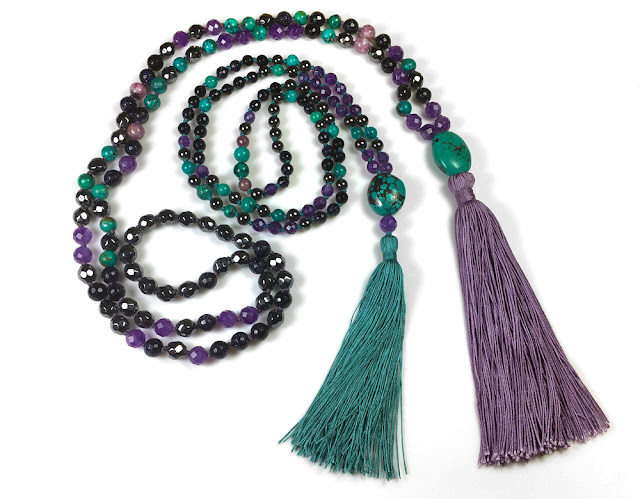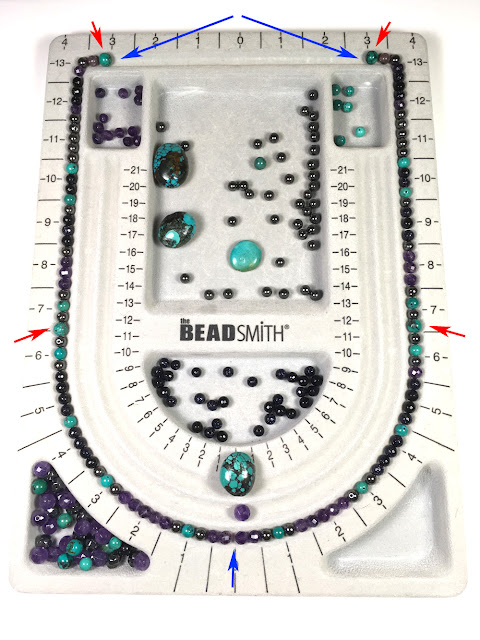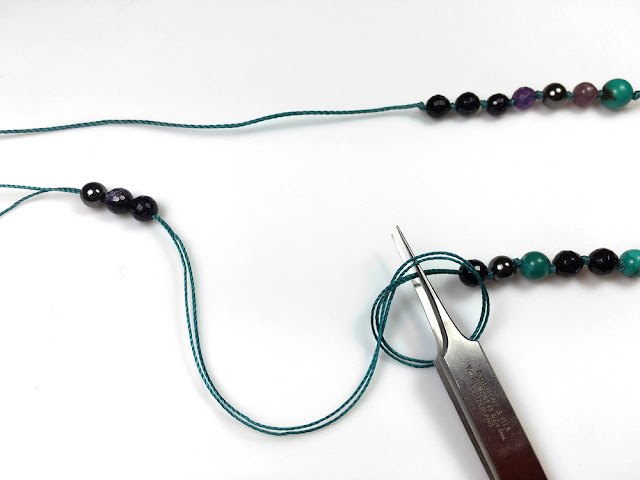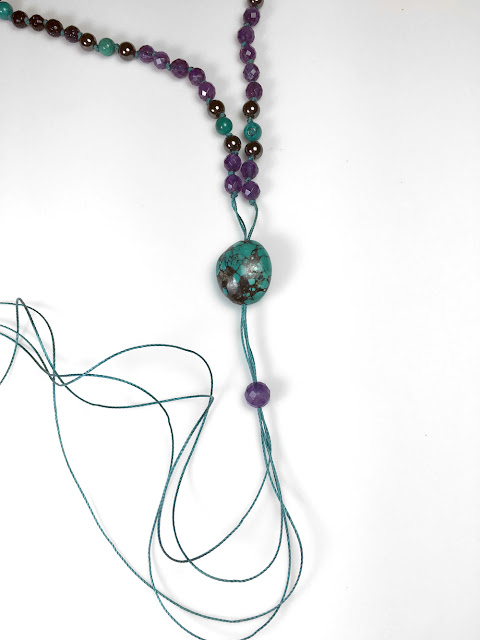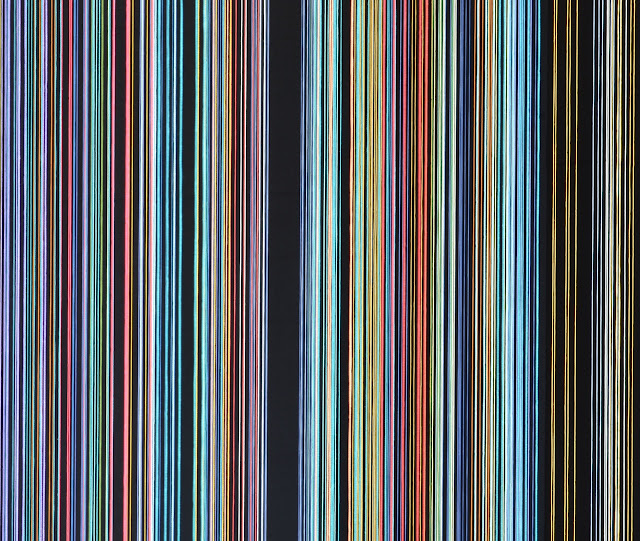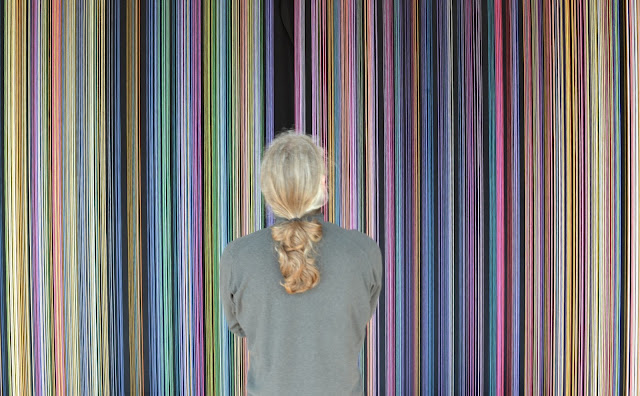Malas are Buddhist prayer beads used for meditation. Traditionally 108 beads are strung and hand knotted in between each bead. A central bead named Guru Bead and a tassel are often added to Malas. These elements, the 108 beads, the marker beads, the Guru bead, and the tassel, all have a symbolic significance explained at the end of this post.
Material & Tools Needed
• 108 Beads
The 8mm Mala shown on this tutorial is made with mostly 8mm beads, the marker beads are a bit larger than the other beads. The beaded part is 96 cm/38 inches long. The tassel and Guru bead add another 15 cm/6 inches. I used a larger oval Turquoise bead as the guru bead and added an amethyst bead above the tassel for color contrast.
- Or 104 6mm beads + 4 marker beads. The Mala shown on the right below, is made this way with 8mm marker beads. It is 76 cm/30 inches long and the Guru bead and tassel add 13.5 cm/5.25 inches. The male on the left is shown in the step by step of this tutorial.

The beads can include round and faceted gemstones, wood beads such as ebony, seed beads, metals beads, or a mix. For this Mala I chose a mix of round and faceted gemstone beads.
The Tassel Tutorial shows how to make the tassel for the 8mm Mala step by step. This tassel here shown below is made with Chinese Knotting Cord Size E (0.4 mm in diameter) wrapped 60 times around a cardboard box lid 24 cm/9.5 inches around. The finished tassel, once trimmed is 10 cm/4 inches long.
A Mala can be made in an afternoon or evening. The processes, choosing the beads, stringing beads, knotting in between the beads, and making the tassel can become a form of meditation. The gemstone beads chosen for the Mala are also important as gemstones have subtle energies that can be felt and should be honored while working on the piece.
These Malas are made with the following gemstones:
Amethyst - Give strength. Helps healing. Increases intuition and helps overcome addictions.
Blue Goldstone - Man-made with copper. Protection stone. Good for meditation. Symbolizes light found in darkness. Good for long distance healing.
Hematite - Grounding and protection stone. Calming.
Turquoise - Helps promote clear communication from the heart. Relieve stress. Protect from pollution.
Lepidolite - Known as the peace stone. Promotes calm and acceptance. Good for the heart chakra. Brings hope in dark times by bringing a sense of balance and calm.
I hope you will find this tutorial helpful. I got a number of questions after writing the tassel tutorial about how to attach the tassel to the strung beads. Making Malas is very enjoyable and I plan to make more in the future. Many variations can be made. I have worn the larger Mala for several months now and it is doing very well. I have not noticed any stretching between the beads, although the knots seem to have relaxed a bit. The bottom of the tassel has flared a bit as the braid has opened, and the very tips of the tassel seem a bit lighter. I do not find it to be a problem, it looks good. The Mala feels good on. And yes, I look forward to wearing the shorter one just made for this post. Namaste! - Marion
Marker Beads - Often marker beads are added to Malas. They have either separate textures or a different diameter than the other beads, but in most instances they are counted in the 108 beads. When crossed while meditating they are there to remind us to stay focused, as a wake up call or gentle reminder.
Japa Meditation - From Sanskrit. Meditative repetition of a mantra or a divine name, a practice found in Buddhism, Hinduism, Jainism, and Sikhism. The mantra or name may be spoken softly, enough for the practitioner to hear it, or it may be spoken within the reciter's mind.
Guru Bead - The center bead represent the teachers we had along the way or the teacher within. Out of respect one must stop at the guru bead and if you want to continue with the meditation counting beads, turn around to continue counting in the opposite direction. It is a good place to reflect on the intentions of your practice.
Tassel - Represents enlightenment, oneness as all the strands are connected together, connecting all to the divine, a symbol for prana and consciousness.
Meditation with the Mala - The Mala beads are used to keep count of the mantras in Japa meditation. Recite your mantra on each bead, going around the entire mala until you get to 108 repetitions of that mantra. A separate mantra can be made when crossing over the marker beads.
Here are some of the choices:
- All 108 beads are 8mm in diameter.
- Or 104 8mm beads + 4 marker beads. The marker beads can be a different size, or have a different texture, or feel.
- All 108 beads are 6mm in diameter.
- All 108 beads are 6mm in diameter.
- Or 104 6mm beads + 4 marker beads. The Mala shown on the right below, is made this way with 8mm marker beads. It is 76 cm/30 inches long and the Guru bead and tassel add 13.5 cm/5.25 inches. The male on the left is shown in the step by step of this tutorial.

The beads can include round and faceted gemstones, wood beads such as ebony, seed beads, metals beads, or a mix. For this Mala I chose a mix of round and faceted gemstone beads.
• The Guru Bead
Larger bead, can a carved buddha bead, in between the 108 beads and the tassel.
• The Cord
Although silk is more traditional, if you are using gemstones and planning on wearing your Mala, bonded nylon is a better choice. It is more durable than silk... and due to its 3-ply twisted cord construction, it does not stretch as much as braided nylon cord (Chinese Knotting Cord).
- C-Lon Bead Cord for 8mm beads - For stringing the beads, and knotting between each bead.
- C-Lon Fine Weight Bead Cord Tex 135 - Recommended for 6mm beads. With the 6mm beads consider using C-Lon Fine Weight Bead Cord Tex 135 instead of the standard C-Lon Bead Cord Tex 210. The knots between the beads are a bit more delicate and the Mala drapes better.
• Chinese Knotting Cord or Silk - For the tassel.
• Tweezers - For knotting between beads.
• Sharp Scissors - For cutting the C-Lon Bead Cord and trimming the tassel
• Beeswax - For stringing beads onto the C-Lon Bead Cord. Optional - wire needles or big eye needle.
• Fray Check - Optional if all the cords do not fit through the Guru bead.
• Bead Tray - A bead mat or towel will work too.
• Tapestry Needle - Size 22 or 20. To pull the cord through the tassel center.
• Chain Nose Pliers - Or any utility pliers to pull the needle through the tassel center.
Step 1 - Laying the Beads
Lay out the beads. The small blue arrow at the bottom is where the Guru bead and tassel will be added. 26 6mm beads are laid out on each side, plus one 8mm marker bead for a 27 beads segment. Do that twice for a total of 54 beads on each side. The red arrows point to the 8mm marker beads. The blue arrows at the top is where the beads will be loaded onto the cord.
I placed an extra amethyst bead below the Guru bead. I may or may not use it in between the guru bead and the tassel. I added it to the 6mm Mala, but not the 8mm Mala. It added contrast with the Teal tassel, but was not necessary for the French Lilac tassel.
Step 2 - Stringing the Beads
Cut two lengths of C-Lon Bead Cord 235 cm/96 inches long. Stretch the cord between your hands. This will remove the 10% stretch of this cord. Make an overhand knot with the 2 cords together right at the center with 117 cm/48 inches on each side.
(Use the Fine Weight size for 6mm beads.)
(Use the Fine Weight size for 6mm beads.)
Make self needles at both ends of the double cord with the beeswax by shredding the ends of the cord with the blade of the scissors, then adding beeswax. Do that a few time until you have a nice point, and cut the end of the point at an angle. Refer to this post on how to load beads onto cord for step by step instructions on how to make a beeswax self needle.
Load a first group of beads. Start at one of the top blue arrows. Knot between the beads with overhand knots. Use tweezers to keep the knot against the bead and use your left index finger and thumb to keep the knot on place when pulling the tweezers off.
Then tighten the knot. You can separate the two cords to do the final pull on the knot.
Continue, loading either one bead or a small group of beads at a time, then knotting in between.
Loading one bead at a time and knotting seems slow, but it is easy. I find it easier and faster to load the beads in small groups, then knotting in between. If you are not sure about the bead layout, loading all the beads at once and on both sides is best for design purposes, but tying the overhand knots between the beads is a bit more awkward as all the beads need to be pulled though the overhand knot before it is tightened.
Here the first side has been done. 54 beads have been strung. Now load and knot the other side, starting at the top arrow. Two 8mm marker beads will be next to one another and will mark the back of the Mala.
Step 3 - Joining at the Guru Bead
Join the ends together and load the Guru bead onto the 4 cords. Add an overhand knot after the bead(s).
If the Guru bead hole is not large enough to accommodate all 4 cords, here are some options. Ream the hole with a diamond reamer until it can accommodate the 4 cords. Or use only one cord from each side. Add a drop of Fray Check on the final knots. Let it dry. Cut one of the cords on each side off and load the Guru beads on the remaining 2 cords.
Step 3 - The Tassel
Make the tassel > Go to Tassel Tutorial, but wait to trim it until it is in place. You can even get it in place onto the C-Lon Bead Cord prior to wrapping the neck.The Tassel Tutorial shows how to make the tassel for the 8mm Mala step by step. This tassel here shown below is made with Chinese Knotting Cord Size E (0.4 mm in diameter) wrapped 60 times around a cardboard box lid 24 cm/9.5 inches around. The finished tassel, once trimmed is 10 cm/4 inches long.
Using a tapestry needle size 22 or 20, pull the C-Lon Bead Cord though the tassel center. Do it one cord at a time so not to disturb the tassel top. If needed, use pliers to pull the needle through.
Load a 'stopper' bead onto the C-Lon Bead Cord. I use a 6mm ebony wood bead with a hole large enough to accommodate all 4 cords. The beads will be right under the tassel skirt.
Make an overhand knot and tighten it against the bead, blocking the tassel in place. Then trim the tassel as shown in the tassel tutorial.
These Malas are made with the following gemstones:
Amethyst - Give strength. Helps healing. Increases intuition and helps overcome addictions.
Blue Goldstone - Man-made with copper. Protection stone. Good for meditation. Symbolizes light found in darkness. Good for long distance healing.
Hematite - Grounding and protection stone. Calming.
Turquoise - Helps promote clear communication from the heart. Relieve stress. Protect from pollution.
Lepidolite - Known as the peace stone. Promotes calm and acceptance. Good for the heart chakra. Brings hope in dark times by bringing a sense of balance and calm.
I hope you will find this tutorial helpful. I got a number of questions after writing the tassel tutorial about how to attach the tassel to the strung beads. Making Malas is very enjoyable and I plan to make more in the future. Many variations can be made. I have worn the larger Mala for several months now and it is doing very well. I have not noticed any stretching between the beads, although the knots seem to have relaxed a bit. The bottom of the tassel has flared a bit as the braid has opened, and the very tips of the tassel seem a bit lighter. I do not find it to be a problem, it looks good. The Mala feels good on. And yes, I look forward to wearing the shorter one just made for this post. Namaste! - Marion
Symbolism
108 - The number 108 is considered sacred in Buddhism and Hinduism. This number represents 108 energy lines that converge to form the heart chakra; 108 Hindu Goddess names; 54 letters of the Sanskrit alphabet, each with a feminine and masculine side (Shakti and Shiva) and 54 times 2 equals 108.Marker Beads - Often marker beads are added to Malas. They have either separate textures or a different diameter than the other beads, but in most instances they are counted in the 108 beads. When crossed while meditating they are there to remind us to stay focused, as a wake up call or gentle reminder.
Japa Meditation - From Sanskrit. Meditative repetition of a mantra or a divine name, a practice found in Buddhism, Hinduism, Jainism, and Sikhism. The mantra or name may be spoken softly, enough for the practitioner to hear it, or it may be spoken within the reciter's mind.
Guru Bead - The center bead represent the teachers we had along the way or the teacher within. Out of respect one must stop at the guru bead and if you want to continue with the meditation counting beads, turn around to continue counting in the opposite direction. It is a good place to reflect on the intentions of your practice.
Tassel - Represents enlightenment, oneness as all the strands are connected together, connecting all to the divine, a symbol for prana and consciousness.
Meditation with the Mala - The Mala beads are used to keep count of the mantras in Japa meditation. Recite your mantra on each bead, going around the entire mala until you get to 108 repetitions of that mantra. A separate mantra can be made when crossing over the marker beads.

